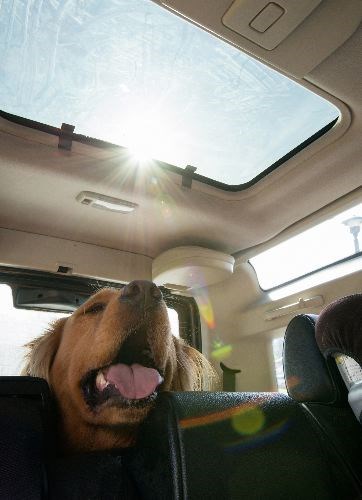With the arrival of summer, the BC SPCA is reminding people to leave their pets at home if they can't keep them safe.
"We can't stress enough that it can be fatal to leave your pet in a hot car, even for 10 minutes, but still we receive hundreds of calls about animals in distress, every year," BC SPCA spokeswoman
Lorie Chortyk said.
"Doing so is so dangerous for your pet - the temperature in a parked car, even in the shade with windows partly open, can rapidly reach a level that will seriously harm or even kill a pet."
In just minutes, the temperature in a parked car can climb to well over 38 degrees Celsius (100 degrees Fahrenheit). Dogs have no sweat glands, so they can only cool themselves by panting and by releasing heat through their paws, Chortyk noted. Dogs can withstand high temperatures for only a very short time - in some cases just minutes - before suffering irreparable brain damage or death.
"If you're used to letting your dog accompany you on errands, you might feel guilty leaving him behind on hot days. But your dog will be much happier - and safer - at home, with shade and plenty of fresh cool water," Chortyk sajd.
If you see an animal you think is in distress, note the license plate and vehicle information and ask managers of nearby businesses to page the owner to return to their vehicle immediately. Then call the BC SPCA animal cruelty hotline at 1-855-622-7722 during business hours (9 a.m.-5 p.m., Mon.-Tues.; 9 a.m.-5:30 p.m., weekends) and staff will help connect you with your local animal control or police. In an emergency, call 911.
It is illegal for members of the public to break a window to access the vehicle themselves. Only RCMP and Special Provincial Constables of the BC SPCA can lawfully enter a vehicle. SPCA branch staff and volunteers cannot enter vehicles.
It also helps to keep emergency supplies available. They include bottled water, a small bowl, a towel that can be soaked in water so you help hydrate an animal (if a window has been left open) while you wait for emergency response. A battery-powered fan from a dollar store also can be handy to circulate air.
Symptoms of heatstroke in pets include exaggerated panting (or the sudden stopping of panting), rapid or erratic pulse, salivation, anxious or staring expression, weakness and muscle tremors,lack of coordination, convulsions, vomiting and collapse.
If your pet shows symptoms of heatstroke, immediately move the animal to a cool, shady place, wet the dog with cool water and fan vigorously to promote evaporation. This will cool the blood, which reduces the animal's core temperature
Do not apply ice - this constricts blood flow, which will inhibit cooling - but allow the animal to drink some cool water or to lick ice cream if no water is available.
Take the animal to a veterinarian as soon as possible for further treatment


